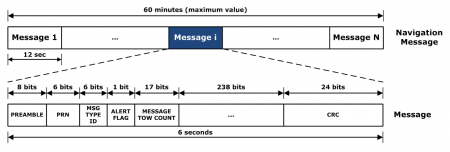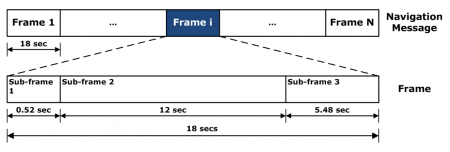If you wish to contribute or participate in the discussions about articles you are invited to contact the Editor
GPS Navigation Message: Difference between revisions
m (Early L2C and L5C transmission.) |
m (Early L2C and L5C transmission.) |
||
| Line 42: | Line 42: | ||
== L5-CNAV == | == L5-CNAV == | ||
Like L2-CNAV, the L5 message-populated broadcast started on April 2014 but set “unhealthy,” but as greater experience with the L5 broadcast and implementation of signal monitoring is achieved, this status may change upon review<ref name=early_cnav_message_populated/>. | Like L2-CNAV, the L5 message-populated broadcast started on April 2014 but set “unhealthy,” but as greater experience with the L5 broadcast and implementation of signal monitoring is achieved, this status may change upon review<ref name=early_cnav_message_populated/><ref>[http://www.insidegnss.com/node/3986 NANU Alerts GPS Users to Start of L2C/L5 CNAV Messages], Inside GNSS, April 24, 2014</ref>. | ||
The L5-CNAV is modulated onto L5I signal component, containing basically the same information data as L2-CNAV. The message structure is exactly the same but its content may vary slightly. | The L5-CNAV is modulated onto L5I signal component, containing basically the same information data as L2-CNAV. The message structure is exactly the same but its content may vary slightly. | ||
Revision as of 16:36, 8 May 2014
| Fundamentals | |
|---|---|
| Title | GPS Navigation Message |
| Author(s) | J. Sanz Subirana, JM. Juan Zornoza and M. Hernandez-Pajares, University of Catalunia, Spain. |
| Level | Basic |
| Year of Publication | 2011 |
Every satellite receives from the ground antennas the navigation data which is sent back to the users through the navigation message. The Navigation Message provides all the necessary information to allow the user to perform the positioning service. It includes the Ephemeris parameters, needed to compute the satellite coordinates with enough accuracy, the Time parameters and Clock Corrections, to compute satellite clock offsets and time conversions, the Service Parameters with satellite health information (used to identify the navigation data set), Ionospheric parameters model needed for single frequency receivers, and the Almanacs, allowing the computation of the position of ”all satellites in the constellation”, with a reduced accuracy (1 - 2 km of 1-sigma error), which is needed for the acquisition of the signal by the receiver. The ephemeris and clocks parameters are usually updated every two hours, while the almanac is updated at least every six days.
Besides the "legacy" L1 C/A navigation message, four additional new messages have been introduced by the so called GPS modernisation: L2-CNAV, CNAV-2, L5-CNAV and MNAV. The "legacy" message and the first three of the modernised GPS are civil messages, while the MNAV is a military message. In modernised GPS, the same type of contents as the legacy navigation message (NAV) is transmitted but at higher rate and with improved robustness.
The messages L2-CNAV, L5-CNAV and MNAV have a similar structure and (modernised) data format. The new format allows more flexibility, better control and improved content. Furthermore, the MNAV includes new improvements for the security and robustness of the military message. The CNAV-2 is modulated onto L1CD, sharing the same band as the "legacy" navigation message.
L1 C/A
The current “legacy” Navigation Message (NAV) is modulated on both carriers at 50 bps. The whole message contains 25 pages (or ’frames’) of 30 seconds each, forming the master frame that takes 12,5 minutes to be transmitted. Every frame is subdivided into 5 sub-frames of 6 seconds each; in turn, every sub-frame consists of 10 words, with 30 bits per word (see figure 3). Every sub-frame always starts with the telemetry word (TLM), which is necessary for synchronism. Next, the transference word (HOW) appears. This word provides time information (seconds of the GPS week), allowing the receiver to acquire the week-long P(Y)-code segment.
The content of every sub-frame is as follows:
- Sub-frame 1: contains information about the parameters to be applied to satellite clock status for its correction. These values are polynomial coefficients that allow converting time on board to GPS time. It also has information about satellite health condition.
- Sub-frames 2 and 3: these sub-frames contain satellite ephemeris.
- Sub-frame 4: provides ionospheric model parameters (in order to adjust for ionospheric refraction), UTC information (Universal Coordinate Time), part of the almanac, and indications whether the Anti-Spoofing, A/S, is activated or not (which transforms P code into the encrypted Y code).
- Sub-frame 5: contains data from the almanac and the constellation status. It allows to quickly identify the satellite from which the signal comes. A total of 25 frames are needed to complete the almanac.
Sub-frames 1, 2 and 3 are transmitted with each frame (i.e., they are repeated every 30 seconds). Sub-frames 4 and 5 contain different pages (25 pages each) of the navigation message (see figure 1). Thence, the transmission of the full navigation message takes 25 × 30 seconds = 12.5 minutes. The content of sub-frames 4 and 5 is common for all satellites. Thence, the almanac data for all in orbit satellites can be obtained from a single tracked satellite.
L2-CNAV
The initial L2C broadcast consisted of a default message (Message Type 0) that did not provided full navigational data. Initially the plan was to keep the dummy transmission until the new Operational Control Segment (OCX) would be operational by 2016. However the Air Force have decided to anticipate the provision of the L2C navigation message with the aim of helping the development of compatible user equipments as well facilitate the CNAV Operations Concept. The message-populated broadcast started on April 2014 with reduced data accuracy and update frequency compared to the legacy GPS signals in wide use today. From December 2014 is planed that L2-CNAV data updates will increase to a daily rate, bringing L2C signal-in-space accuracy on par with the legacy signals. However, derived position accuracy cannot be guaranteed during the pre-operational deployment of the frequencies and its use must be used only for testing and research activities despite the health bit set “healthy”[1].
Its design replaces the use of frames and sub-frames of data (repeating in a fixed pattern) of the original “legacy” NAV by a packetised message-based communications protocol, where individual messages can be broadcast in a flexible order with variable repeat cycles as represented in figure 2. Moreover, Forward Error Correction (FEC) and advanced error detection (such as a CRC) are used to achieve better error rates and reduced data collection times.
Each message is composed by fixed data such as a Preamble, Message Type ID, Alert Flag, Message TOW count and CRC which lets 238 bits to be filled with other navigation related data. It is possible to define up to 63 different message types, but currently only the messages types 10-14 and 30-37 are defined. The remaining undefined and unused message types are reserved for future use. Broadcast of messages is completely arbitrary, but sequenced to provide optimum user performance.
L5-CNAV
Like L2-CNAV, the L5 message-populated broadcast started on April 2014 but set “unhealthy,” but as greater experience with the L5 broadcast and implementation of signal monitoring is achieved, this status may change upon review[1][2].
The L5-CNAV is modulated onto L5I signal component, containing basically the same information data as L2-CNAV. The message structure is exactly the same but its content may vary slightly.
CNAV-2
The message CNAV-2 consists of sub-frames and frames and is modulated onto the L1CD signal. Each frame is divided into three sub-frames of varying length being required multiple frames to broadcast a complete data message set to users.
References
- ^ NANU Alerts GPS Users to Start of L2C/L5 CNAV Messages, Inside GNSS, April 24, 2014
- DoD, USA, 1995 Global Positioning System Standard Positioning Service Performance Standard.
- DoD, USA, 2007 Global Positioning System Precise Positioning Service Performance Standard.
- DoD, USA, 2008 Global Positioning System Standard Positioning Service Performance Standard.
- GPS Joint Program Office, 2004 Navstar GPS Space Segment / Navigation User Interfaces (IS-GPS-200D).
- Mc Donald, K. and Hegarty, C., 2000. Modernization GPS Performance Capabilities. In: Proceedings of ION 56th Annual Meeting, 25-26 June 2000, San Diego California USA, pp. 242-249.




